
Jewellery consists of decorative items worn for personal adornment, such as brooches, rings, necklaces, earrings, pendants, bracelets, and cufflinks. Jewellery may be attached to the body or the clothes. From a western perspective, the term is restricted to durable ornaments, excluding flowers for example. For many centuries metal such as gold often combined with gemstones, has been the normal material for jewellery, but other materials such as glass, shells and other plant materials may be used.
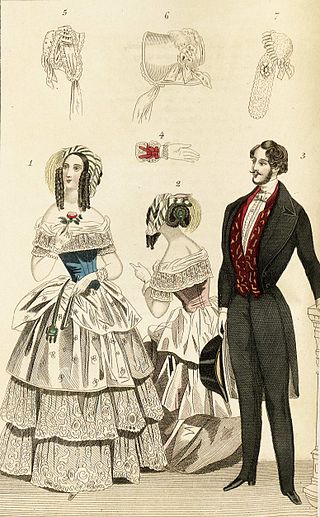
Victorian fashion consists of the various fashions and trends in British culture that emerged and developed in the United Kingdom and the British Empire throughout the Victorian era, roughly from the 1830s through the 1890s. The period saw many changes in fashion, including changes in styles, fashion technology and the methods of distribution. Various movement in architecture, literature, and the decorative and visual arts as well as a changing perception of gender roles also influenced fashion.

Mourning is the expression of an experience that is the consequence of an event in life involving loss, causing grief, occurring as a result of someone's death, specifically someone who was loved although loss from death is not exclusively the cause of all experience of grief.
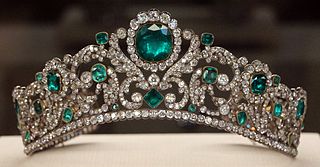
A tiara is a jeweled head ornament. Its origins date back to ancient Greece and Rome. In the late 18th century, the tiara came into fashion in Europe as a prestigious piece of jewelry to be worn by women at formal occasions. The basic shape of the modern tiara is a (semi-)circle, usually made of silver, gold or platinum, and richly decorated with precious stones, pearls or cameos.

A necklace is an article of jewellery that is worn around the neck. Necklaces may have been one of the earliest types of adornment worn by humans. They often serve ceremonial, religious, magical, or funerary purposes and are also used as symbols of wealth and status, given that they are commonly made of precious metals and stones.

A brooch is a decorative jewelry item designed to be attached to garments, often to fasten them together. It is usually made of metal, often silver or gold or some other material. Brooches are frequently decorated with enamel or with gemstones and may be solely for ornament or serve a practical function as a clothes fastener. The earliest known brooches are from the Bronze Age. As fashions in brooches changed rather quickly, they are important chronological indicators. In archaeology, ancient European brooches are usually referred to by the Latin term fibula.

Jet is a type of lignite, the lowest rank of coal, and is a gemstone. Unlike many gemstones, jet is not a mineral, but is rather a mineraloid. It is derived from wood that has changed under extreme pressure.

A parure is a set of various items of matching jewelry, which rose to popularity in early 19th-century Europe.
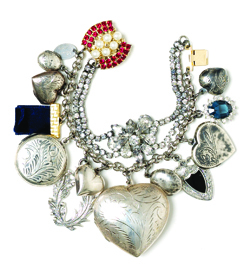
A charm bracelet is a type of bracelet which carries personal jewelled ornaments or "charms", such as decorative pendants or trinkets. The decorative charms usually carry personal or sentimental attachment by the owner.

Hairwork, or jewelry or artwork made of human hair, has appeared throughout the history of craft work, particularly to be used for private worship or mourning. From the Middle Ages through the early twentieth century, memorial hair jewelry remained common. Hair, considered to be a remnant off the person it was cut from, also has often played a part in myths and legends; in a Swedish book of proverbs, one can read that “rings and bracelets of hair increase love”. One example can be found in Denmark, at Rosensborg’s palace, which is a bracelet of precious metal with a simple braided lock of hair - a gift from King Christian IV (1577-1648) to his queen. Another example would be the rings commemorating the execution of King Charles I of England (1600-1649), which circulated among his faithful supporters. Other famous people who owned hair jewelry include Napoleon, Admiral Nelson, Queen Victoria and her large family, Christina Nilsson and Jenny Lind.
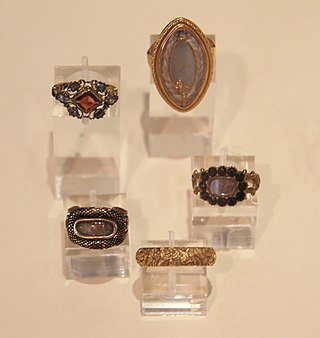
A mourning ring is a finger ring worn in memory of someone who has died. It often bears the name and date of death of the person, and possibly an image of them, or a motto. They were usually paid for by the person commemorated, or their heirs, and often specified, along with the list of intended recipients, in wills. Stones mounted on the rings were usually black, and where it could be afforded jet was the preferred option. Otherwise cheaper black materials such as black enamel or vulcanite were used. White enamel was used on occasion particularly where the deceased was a child. It also saw some use when the person being mourned had not married. In some cases a lock of hair of the deceased person would be incorporated into the ring. The use of hair in mourning rings was not as widespread as it might have been due to concerns that the hair of the deceased would be substituted with other hair.

Queen Elizabeth II owned a historic collection of jewels – some as monarch and others as a private individual. They are separate from the gems and jewels of the Royal Collection, and from the coronation and state regalia that make up the Crown Jewels.
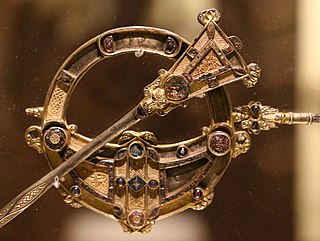
The Celtic brooch, more properly called the penannular brooch, and its closely related type, the pseudo-penannular brooch, are types of brooch clothes fasteners, often rather large; penannular means formed as an incomplete ring. They are especially associated with the beginning of the Early Medieval period in Ireland and Britain, although they are found in other times and places—for example, forming part of traditional female dress in areas in modern North Africa.
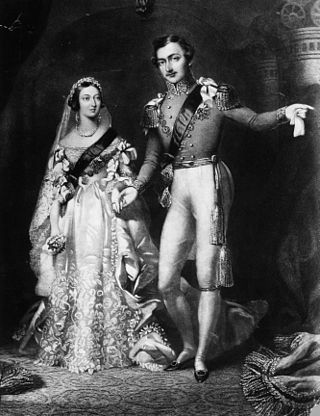
Queen Victoria of the United Kingdom married Prince Albert of Saxe-Coburg and Gotha on 10 February 1840. She chose to wear a white wedding dress made from heavy silk satin, making her one of the first women to wear white for their wedding. The Honiton lace used for her wedding dress proved an important boost to Devon lace-making. Queen Victoria has been credited with starting the tradition of white weddings and white bridal gowns, although she was not the first royal to be married in white.

The Middle Ages was a period that spanned approximately 1000 years and is normally restricted to Europe and the Byzantine Empire. The material remains we have from that time, including jewelry, can vary greatly depending on the place and time of their creation, especially as Christianity discouraged the burial of jewellery as grave goods, except for royalty and important clerics, who were often buried in their best clothes and wearing jewels. The main material used for jewellery design in antiquity and leading into the Middle Ages was gold. Many different techniques were used to create working surfaces and add decoration to those surfaces to produce the jewellery, including soldering, plating and gilding, repoussé, chasing, inlay, enamelling, filigree and granulation, stamping, striking and casting. Major stylistic phases include barbarian, Byzantine, Carolingian and Ottonian, Viking, and the Late Middle Ages, when Western European styles became relatively similar.

Ancient Roman jewelry was characterized by an interest in colored gemstones and glass in contrast with their Greek predecessors, who focused primarily on the production of high-quality metalwork by practiced artisans. Extensive control of Mediterranean territories provided an abundance of natural resources to utilize in jewelry making. Participation in trade allowed access to both semi-precious and precious stones that traveled down the Persian Silk Road from the East. Various types of jewelry were worn by different genders and social classes in Rome, and were used both for aesthetic purposes and to communicate social messages of status and wealth. Throughout the history of the Roman Empire, jewelry style and materials were influenced by Greek, Egyptian, and Etruscan jewelry.

Scottish jewellery is jewellery created in Scotland or in a style associated with Scotland, which today often takes the form of the Celtic style. It is often characterised by being inspired by nature, Scandinavian mythology, and Celtic knot patterns. Jewellery has a history in Scotland dating back to at least the Iron Age.
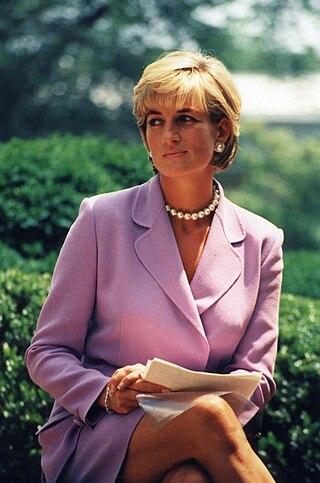
Diana, Princess of Wales, owned a collection of jewels both as a member of the British royal family and as a private individual. These were separate from the coronation and state regalia of the crown jewels. Most of her jewels were either presents from foreign royalty, on loan from Queen Elizabeth II, wedding presents, purchased by Diana herself, or heirlooms belonging to the Spencer family.
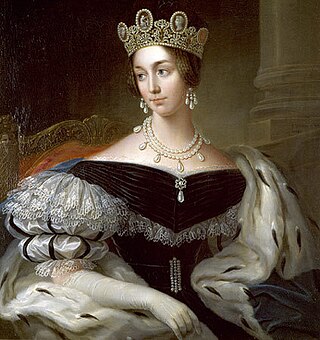
Jewelry of the Swedish Royal Family is the set of ceremonial jewels been owned by members of the Swedish royal family or by the Bernadotte family foundations. The Swedish national regalia, which have a symbolic meaning and are not to be regarded as jewelry, are, on the other hand, owned by the Swedish state.

Jewels! The Glitter of the Russian Court was the second jubileum exhibition in Amsterdam by the Hermitage Amsterdam, focussed on the personal taste for luxury by Russian nobility. The show, which was planned to run from 14 September 2019 to 15 March 2020, suffered from the pandemic and was extended twice, ending finally 16 October 2020.



























